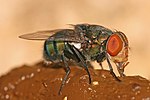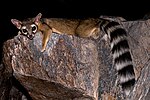Animal latrines (latrine areas, animal toilets, defecation sites) are places where wildlife animals habitually defecate and urinate. Many kinds of animals...
9 KB (896 words) - 18:40, 18 June 2024
Animal toilet may refer to: Animal latrine, wildlife dedicated defecation site Litter box, pet defecation site Animal grooming; see Groom (disambiguation)...
196 bytes (53 words) - 21:16, 16 November 2022
Pig toilet (redirect from Pig latrine)
A pig toilet (sometimes called a "pig sty latrine") is a simple type of dry toilet consisting of an outhouse mounted over a pigsty, with a chute or hole...
6 KB (641 words) - 14:46, 4 June 2024
Archaeological Society of British Columbia since 1968 Landfill Waste management Animal latrine This disambiguation page lists articles associated with the title Midden...
618 bytes (118 words) - 17:17, 21 October 2022
their natural instincts, but for a dog it can be more challenging. Animal latrine Cat intelligence Gravel Litter boxes in schools hoax Sandpit In Feldman's...
29 KB (3,667 words) - 17:20, 23 June 2024
Toilet (section Pit latrine)
pits, in which case it is called a "pour flush pit latrine" or a "twin pit pour flush to pit latrine". It can also be connected to a septic tank. Flush...
57 KB (7,699 words) - 09:36, 9 June 2024
List of countries by proportion of the population using improved sanitation facilities (redirect from Countries using latrines)
effectively prevent human, animal, and insect contact with excreta. Improved facilities range from simple but protected pit latrines to flush toilets with...
14 KB (612 words) - 23:19, 4 October 2023
Coprophagia (section Coprophagia by nonhuman animals)
other's anus and ingest biologically significant amounts of feces. Some animal species eat feces as a normal behavior, in particular lagomorphs, which...
22 KB (2,219 words) - 01:40, 22 June 2024
Tasmanian devil (redirect from Tasmanian Devil (animal))
places to defecate, and to do so at a communal location, called a devil latrine. It is believed that the communal defecation may be a means of communication...
116 KB (13,813 words) - 01:51, 21 June 2024
Chrysomya megacephala (redirect from Oriental latrine fly)
Chrysomya megacephala, more commonly known as the oriental latrine fly or oriental blue fly, is a member of the family Calliphoridae (blowflies). It is...
23 KB (2,780 words) - 10:57, 10 July 2024
Urination (redirect from Animal urine)
a "latrine" where their urine can be collected for wastewater treatment, which could be used to reduce greenhouse gas emissions from the animals' urine...
62 KB (6,876 words) - 20:17, 23 June 2024
Dung midden (category Animal communication)
depositing plant seed there. Many gazelle species use middens (see also Animal latrine) for activities related to territory maintenance, advertisement and...
27 KB (3,226 words) - 21:24, 28 April 2024
on a public character: the baths were given a new entrance and a large latrine. A grand monumental entrance was built, off-axis to the peristyle but aligned...
22 KB (2,596 words) - 12:35, 1 July 2024
observes, the pig is a filthy animal, and if swine were used for food, marketplaces and even houses would be dirtier than latrines. Rashi (the primary Jewish...
14 KB (1,745 words) - 12:26, 26 June 2024
from wastewater treatment processes: 23–25 or as fecal sludge from pit latrines and septic tanks. The term is also sometimes used as a generic term for...
2 KB (261 words) - 18:21, 23 February 2024
carrying in fresh bedding and removing soiled material, and they defecate in latrines strategically situated outside their setts or en route to other setts....
69 KB (8,192 words) - 19:12, 7 July 2024
(Bassariscus astutus) during the non-breeding period: Spatial characteristics of latrines and single faeces". Chemoecology. 16 (4): 219–222. Bibcode:2006Checo..16...
16 KB (1,807 words) - 19:02, 7 July 2024
Fannia scalaris (redirect from Latrine fly)
Fannia scalaris, also known as the latrine fly, is a fly species in the Fanniidae family. This species is smaller and more slender than the house fly...
10 KB (1,190 words) - 02:47, 27 April 2023
accidentally cause myiasis are: Musca domestica (housefly) Fannia spp. (latrine flies) Eristalis tenax (rat-tailed maggots) Muscina spp. The adult flies...
36 KB (4,124 words) - 22:20, 7 November 2023
is still possible to lessen problems in that they tend to designate a latrine area, which can have a litter pan placed in it as is done with many ferrets...
21 KB (2,453 words) - 20:38, 7 July 2024
Intestinal parasite infection (category Parasites of animals)
facilities. While this is high, 93% did have access to a latrine, but only 29.2% of those latrines had proper construction to decrease parasitic infections...
15 KB (1,681 words) - 01:02, 30 May 2024
spraint at latrine sites, using their hind feet and tails. Large groups smeared more than groups of three or fewer animals. The frequency of latrines with smeared...
24 KB (2,693 words) - 01:46, 4 July 2024
stating that "open defecation was more pleasurable and desirable than latrine use". In some societies, open defecation is an intentional and widely used...
62 KB (6,104 words) - 19:26, 17 June 2024
very broadly as what accumulates in onsite sanitation systems (e.g. pit latrines, septic tanks and container-based solutions) and specifically is not transported...
54 KB (6,891 words) - 18:20, 19 April 2024
seed dispersal by African civets in the Afromontane Highlands: too long a latrine to be effective for tree population dynamics". African Journal of Ecology...
27 KB (2,943 words) - 16:10, 10 July 2024
yards for food. Keeping raccoons as pets is strongly discouraged. Raccoon latrines in and around homes should be checked for and cleaned as soon as possible...
14 KB (1,680 words) - 11:24, 18 April 2024
e.g. from septic tanks and pit latrines. They also transport sewage sludge, industrial liquids, or slurries from animal waste from livestock facilities...
13 KB (1,675 words) - 01:57, 23 April 2024
ranges and identify individuals. Urine and feces left at shared raccoon latrines may provide additional information about feeding grounds, since raccoons...
123 KB (13,438 words) - 03:35, 12 July 2024
Pliocene. During the Middle Pleistocene, it inhabited what is now Kenya. Latrines made by brown hyenas have been discovered in South Africa dating back to...
18 KB (1,950 words) - 14:12, 9 July 2024
"Attraction of adult Silphidae and Staphylinidae (Coleoptera) to river otter latrines". Journal of the Acadian Entomological Society. American Carrion Beetle...
16 KB (2,023 words) - 00:02, 21 May 2024


























